#Linus and Lucy style :]
Explore tagged Tumblr posts
Text

My root beer partner in crime. 🤎🍺
#root beer#root beer float#ice cream#ice cream sundae#pop art#andy warhol#snoopy#snoopy art#charlie brown#charles m schulz#great pumpkin#joe cool#summertime#childhood memories#cell animation#cartoon strip#cartoon art#animation#animation art#animated#animated tv series#animated tv show#lucy van pelt#linus van pelt#peanuts#peanuts gang#craft beer#kombucha#cartoon style#cartoon series
125 notes
·
View notes
Text
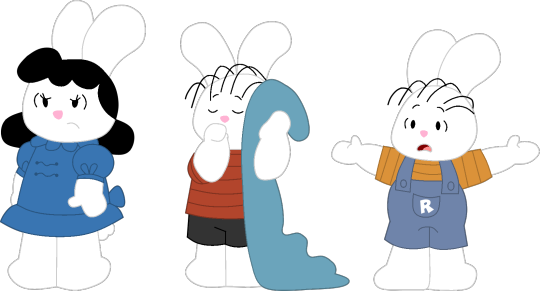
Here's Lucy, Linus, and Rerun drawn in my style. I decided to draw them as bunnies. Why bunnies? Well it was the first thing that popped into my head when deciding on what animal to draw them as.
#peanuts#peanuts fanart#peanuts comics#lucy van pelt#linus van pelt#rerun van pelt#bunnies#rabbits#bunny rabbit#siblings#bunny#rabbit#different style
12 notes
·
View notes
Note
how's your current project going?
WAU THANK YOU FOR ASKING! My exhibition reception is this coming Monday, so the past few weeks have been me scrambling to make sure orders are in, writing my thesis, organizing all the bits and bobs, everything that would make any normal person stressed beyond belief! /silly
All of the artwork is officially done though :) so I’m very excited to share more soon!! For now have a silly warmup of the Souls cast uhhh uhhhh dancing!! Celebrating the completion of all of this work! :D
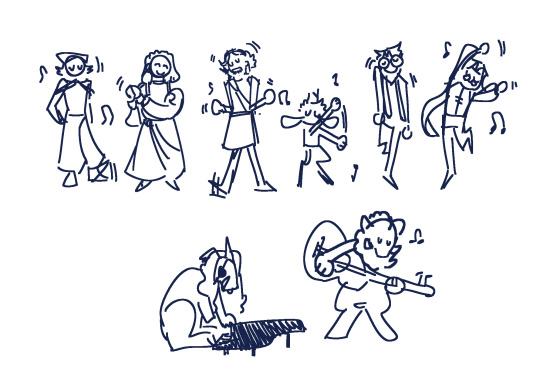
#Linus and Lucy style :]#souls in the sand#souls sillies#ask#anon#my ocs#Esra#Gale#Lucian#wren#Harlow#Perinnet#rue#alo#minecraft oc#art escapades
104 notes
·
View notes
Text
Let's Read Peanuts (Yup, still at it) – May 1954
There are lots of great strips I just don't have room to comment on. I strongly encourage everybody to read the full month at the official GoComics page. Today's month starts HERE.
May 3, 1954

~tugs collar~
Yeah... About that.
May 9, 1954
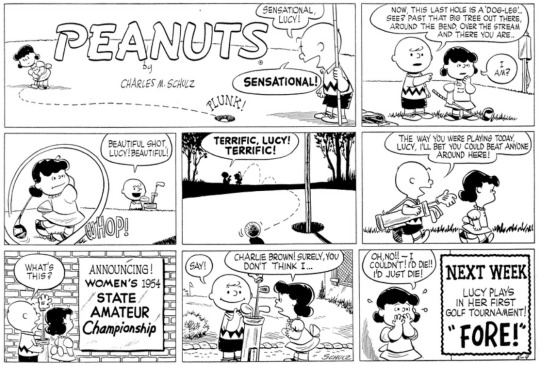
Aw yeah, here we go! I was wondering when this would pop up.
May 15, 1954

1) That's not a joke
2) Yes, Violet. I got that from him kicking the radio.
Also I hope you enjoyed this strip because “Charlie Brown doesn't like coconut” is now a running gag.
May 16, 1954
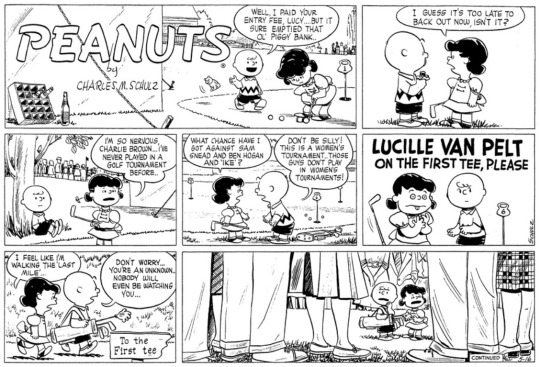
This definitively proves that adults exist in the Peanuts Cinematic Universe, they just happen to be 20 feet tall for some reason. Or maybe the kids are like 2 feet tall? It depends on how you look at it I guess.
May 23, 1954
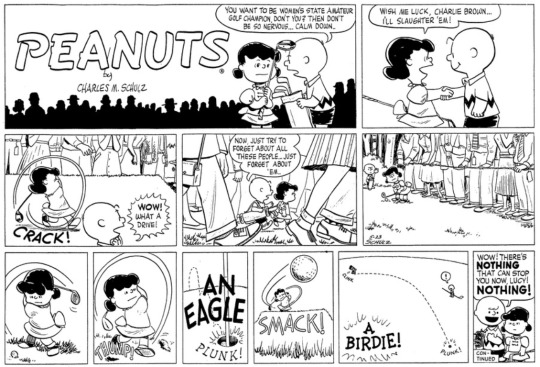
Oh man! What's going to happen!? I'm freaking out!
May 24, 1954

Lucy is so unbelievably awful to Linus in these early years. Granted, she's literally four(?) years old so I can cut her a bit of slack but god damn do these kind of interactions not endear you to her.
Weirdly enough though, I actually like that the strip doesn't punish her for doing stuff like this. Others have made this observation long before I came along but the fact that Schulz is willing to just sort of... let bad things happen without immediately having the universe make an example of the perpetrator or teach them a lesson is one of the things that sets Peanuts apart from the competition. Life just kind of be like that sometimes and it's OK to show it.
May 30, 1954
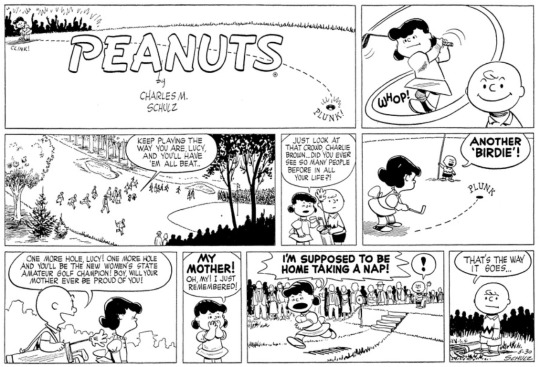
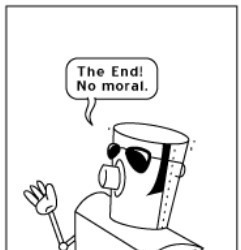
(No, really. That's the last one)
Thoughts:
The golf tournament arc is kind of notorious and nobody really knows what the hell is up with it. You have continuity in the Sunday strips (very unusual due to how they are made), weird off-model art, the cast acting out of character, and of course, on-screen adults. Then it all just kind of... stops. It's very odd.
I've heard people speculate that this might actually have been ghost drawn (is that a term?) by another artist but I'm not sure if I buy that. The art is a bit different but it still very much feels like Schulz to me, particularly in how he draws his backgrounds. I ~do~ think there might be something to the idea that this is a repurposed experiment from another project though.
What this feels like to me is Schulz experimenting with “bigger” stories, perhaps something intended to be sold as a proper comic book rather than just a collection of strips. The art looks different because he's trying to set it apart from the strips by adding more detail and action (kind of like when an animated TV sitcom gets a theatrical movie).
As for why it just ends like that? Well that's a sort of punchline Schulz does in a lot in his daily strips so it's not actually that weird if you think about it. I think he just didn't realize that this kind of anticlimax punchline works with a 4-panel strip but not a 4-page event comic.
There's no official word on the matter though so your guess is as good as mine.
#peanuts#comics#peanuts comics#comic strips#charles schulz#charlie brown#lets read#snoopy#Violet#Schroeder#Lucy#Linus#golf#golf tournament#Read the strip from May 20th. I didn't have room for it but I thought it was pretty funny.#If those were ghost drawn than the artist gets insane props from me for coming remarkably close to Schulz's style. Good job dude.#The Unpacking Peanuts podcast did a pretty good episode on the golf tournament. It's worth checking out.
13 notes
·
View notes
Photo
I finally found something that looks exactly like the art style I want.
I am pretty close to it, but HOW DO YOU DRAW HAIR SO GOOD IN THIS STYLE!!
Can someone please give me tips?
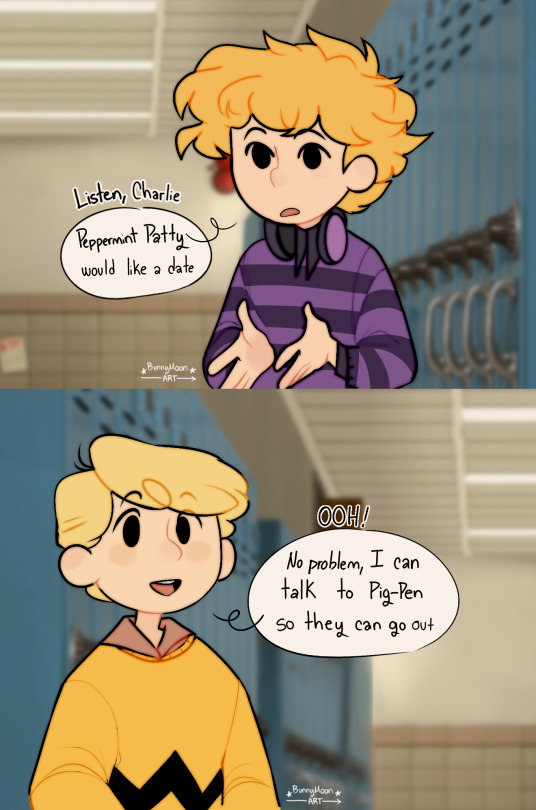
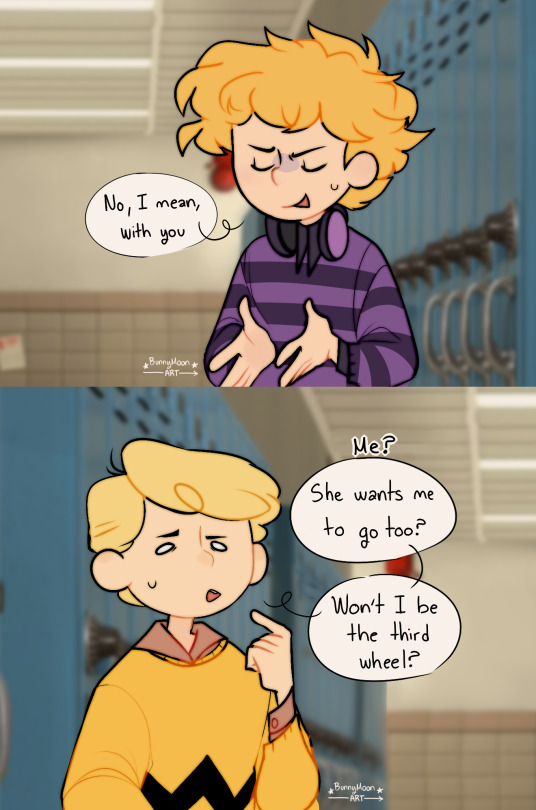
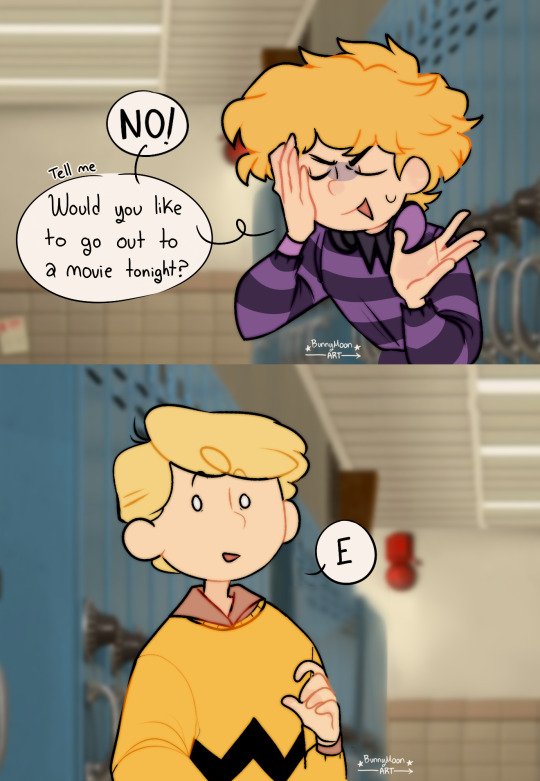

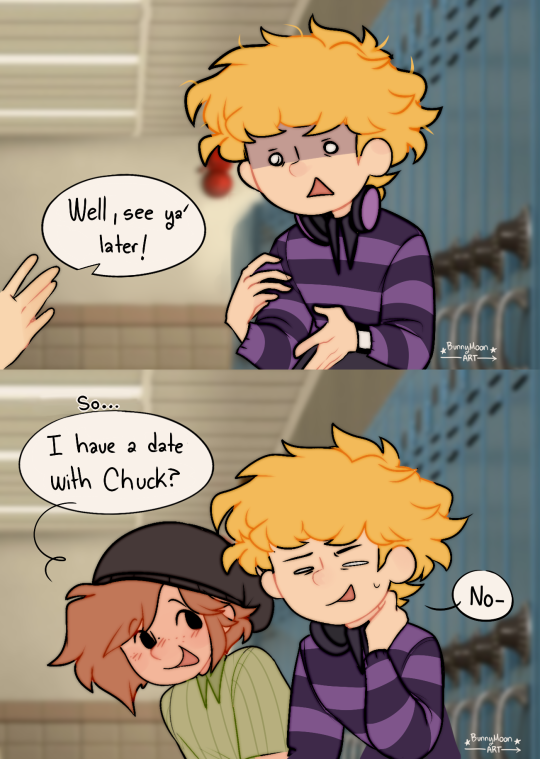
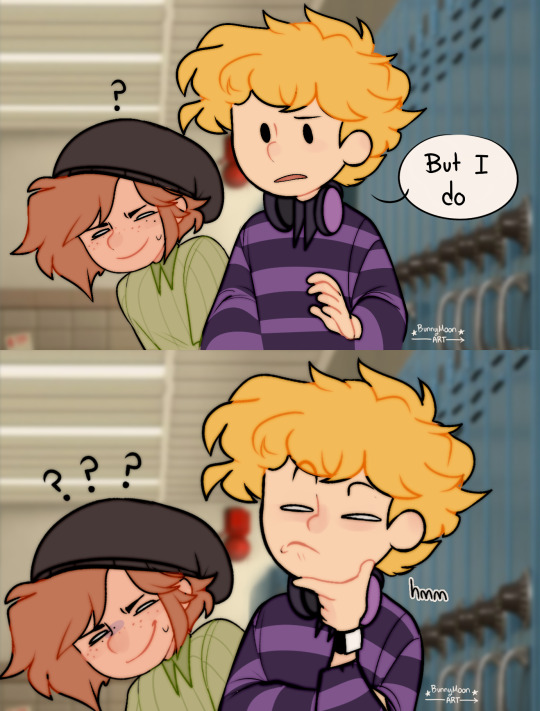
Works to me
#Peanuts#charliebrown#charlie brown#snoopy#Peanuts Gang#Linus Van Pelt#lucy van pelt#Schroeder#sally brown#cartoon#Good ol' charlie brown#Peanuts GrownUp#Peanuts Grown Up#Carlo Cafe#art tag#artwork#art#artists on tumblr#digital art#drawings#illlustration#art style#help
1K notes
·
View notes
Text
the book report song is going to be so fun. I think it'll end up being mh favorite part of rhe musical when we do the shows. like no more was my favorite last year
#.txt#no more was my favorite bc i got to bring the lights up fun style and soap and nathan had so much fun forwvwr#thelights for the book reprt are going to be SO beautifuli think itll be the most complicayed song. because it deserves it#full stage up top of the song. dim them. sl spot on lucy. sr spot on schroeder. lights up woth purple backlight for him to RUN#sl spot on lucy again. sr spot on linus. center spot on cb and slowly get rid of linus while he keeps talking. sl spot on lucy!#lights UP AGAIN FOR SCHROEDER yes. back to lucy. bqck to schroeder! SCARY RED LIGHTS FOR RABBITS RABBITS RABBITS#cenrer spot and sl spot for cb and lucy popping off. add linus sr spot AND ALL LIGHTS UPPPPPPPP EPIC STYLE#lights down. sl spot on lucy. slowly bring up again as they go scary. RED AND SPOT I HAVENT EVEN STARTED YET full lights up. BLACKOUT#Hmmm. They call me neurotypical. By the way
1 note
·
View note
Text
How “Peanuts” Created a Space for Thinking

Charles Schulz’s beloved comic strip invited readers to contemplate the big picture on a small scale.
By Nicole Rudick August 6, 2019

Illustration Courtesy Peanuts Worldwide
In “The Storyteller,” an essay from 1936, the German-Jewish philosopher and critic Walter Benjamin describes what he sees as the beginning of the end of the oral tradition in the West. The collective trauma of the First World War and its aftereffects were making the communication of shared experiences through the telling of tales a thing of the past. He writes, “A generation that had gone to school on a horse-drawn streetcar now stood under the open sky in a countryside in which nothing remained unchanged but the clouds, and beneath these clouds, in a field of force of destructive torrents and explosions, was the tiny, fragile human body.” At the heart of this historical process is a grim efflorescence of experience: the sense that one is adrift in an unfamiliar landscape, a feeling that would endure as a defining condition of the twentieth century, when the world was expanding and becoming delimited at the same time. A few decades after Benjamin published his essay, the writer Luc Sante and his parents immigrated to the United States from Belgium. Sante’s mother and father spoke very little English, and, “tinged with a certain bitter realism,” they observed the foreign culture that surrounded them from an intimidating distance, as Sante explains in his introduction to “Peanuts Every Sunday: 1961-1965.” “It wasn’t surprising, then,” Sante continues, “that my father, an intelligent, capable man who had been dealt a series of bad hands by life—poverty, war, a truncated education—should see himself reflected in Charlie Brown.” Though he would come to be domesticated and beloved by Americans of all stripes, Charles Schulz’s comic-strip boy spoke to the émigré’s sense of dislocation, tough luck, and calamity.
There may be no more tiny, fragile body than Charlie Brown’s—the abbreviated torso, economized limbs, and naked, vulnerable head. That head: with a modicum of lines, Schulz produced an untouched, capacious orb on which a world of expression could play. In the Sunday strip for October 15, 1961, the title panel shows Charlie Brown’s head as a table globe, imprinted with a grid of latitude and longitude. The strip spins out the joke: to illustrate to Linus the distance between two locations (the absurd pairing of Texas and Singapore), Lucy plots the points over the top of Charlie Brown’s bare, impassive pate.
Surrounding this vulnerable human form is a wider world: hostile, exhausting, potent in its occasions for failure. Untethered from the historical moment, Benjamin’s agents of change, those “torrents and explosions” (like Hamlet’s enduring “whips and scorns of time,” which extend even to include the intimate “pangs of despised love”) are here as perennial humiliations played out in a fathomably unfathomable universe. “Peanuts,” Schulz once said, “deals in defeat.” At its core, the comic parses existential angst, strip by strip—not Cold War anxiety, a cloud under which “Peanuts” developed and flourished, but the garden-variety anxieties found in everyday life. Charlie Brown is the comic’s everyman (“Of all the Charlie Browns in the world, you’re the Charlie Browniest,” Linus complains in a 1965 “Peanuts” TV film), adept at losing one day and still rising the next to see things through. And yet, as grounded in real life as it seems to be, “Peanuts” shows very little of the actual world. The comic is striking for its spare visual details, its generic, repetitious settings, and its constrained action. Although the early strips were busy with detail, Schulz soon developed a style that was formally minimal. There is little in the way of depth perspective—and the action in each panel moves right and left, as if on a stage.

Illustration Courtesy Peanuts Worldwide
I remember noticing, as a child, this circumscribed world in which Charlie Brown and the gang air their problems. It was so markedly different from that of another deeply felt, philosophical comic of my youth, “Calvin and Hobbes,” which visually and imaginatively bursts at the seams. In the “Peanuts” strip from Sunday, June 9, 1963, Charlie Brown and Sally admire the night sky as he explains the future movement of the stars that make up the Big Dipper. All eight panels depict the same scene: Charlie Brown and Sally atop a patch of earth, the dark sky engulfing their bodies. Nothingness surrounds them—both formally, on the page, and literally, in the black yawn of space. Nothing much happens here, yet, in its openness and conversation, the strip is alive with wonder, possibility, and humanity. Schulz does a lot with nothingness. In another Sunday strip, from November 19, 1961, the title panel sets Charlie Brown’s round head alongside the great round face of a clock (his anxious expression and bird’s nest of hair make his features a counterpoint to the clock’s uniformity). We are invited to consider the solitude of the school lunch hour, when Charlie Brown must sit with his thoughts, literally: each of the panels below the top row features the lone figure and a speech bubble giving voice to his interior monologue. The spareness of each frame rivals that of the stage set for Beckett’s “Waiting for Godot”: only a bench and a paper-bag lunch. It’s no accident that the evenly distributed, postage-stamp-size panels number twelve, like the hours on a clock. Each movement of Charlie Brown’s head—he looks out and down, then up and right—is activated by the reader’s eye moving in rhythm from panel to panel to panel, like the ticking of a second hand.
That rhythmic deliberateness—specifically its leisurely meter—is essential to the way that “Peanuts” functions as a space for thought. A “Peanuts” strip, even one seemingly packed with goings-on, unfolds patiently. The strip from Sunday, April 18, 1965, depicts a disagreement (sparked by Lucy, of course) on the pitcher’s mound. Lucy wants Charlie Brown, who’s pitching, to “brush this guy back,” but Charlie Brown refuses, and an argument about morality ensues. Charlie Brown’s qualms about throwing a beanball make him a world-historical hypocrite, according to the others. “What about the way the early settlers treated the Indians? Was that moral? How about the Children’s Crusade? Was that moral?” Each new panel brings a fresh participant and perspective to the mound, and accusations become colloquy. By the penultimate panel, ten players stand on or around Charlie Brown’s perch (a pulpit overrun by parishioners), and five speech balloons, thick with philosophical reasoning (“Define morality!”), fill the sky over their heads. But Schulz makes order out of this chaos, arraying his characters in a single line (the panel is unambiguously “Last Supper”–ish, with characters, except for Charlie Brown, grouped in threes). One reads the scene from left to right, both together with and independent of the dialogue—a tidy progression that can be taken in with a serene sweep of the eye. (The thoughtful pacing in “Peanuts” is reminiscent of that of “Mister Rogers’ Neighborhood.” The two also share a rejection of the violence and manic energy that characterize other children’s media of the time.) The rhythm of the larger Sunday strips is particularly effective, as they have more space in which to work. But the same effect plays out on a smaller scale in the dailies. In a four-panel baseball strip from August 5, 1972, Lucy harangues Charlie Brown from left field. The entire top half of the second panel is tightly packed with her rant, rendered in a thicket of bold type and punctuated at the end with an eye-catching, electrifying “BOOOOOOO!!” Her energy is palpable, but it cannot last. In the next panel, she sits on the ground, alone and silent, like a calm ocean, and the reader’s eye rests on her form and the open white space surrounding it for a surprisingly long time before moving on to the last, bitterly self-reflective panel.
Few comic strips feel more like a series of vignettes than “Peanuts,” especially when the already minimal scenery disappears in favor of empty white or monochrome backdrops, as though a thick curtain has descended to pull a character further out of time and into some more concentrated realm of feeling. The generous allotment of white space in the daily strips originated not from design but from necessity. As David Michaelis details in “Schulz and Peanuts: A Biography,” the comic strip was first sold as a potential space filler to be used in any section of a newspaper, even the classifieds. To draw the reader’s eye, Schulz opted for the less-is-more approach, aiming to “fight back” with white space to echo what he once called the strip’s “very slight incidents.” The usefulness of that simplicity became clear as Schulz’s writing deepened. “The more they developed complex powers and appetites while staying faithful to their cut-out, shadow-play simplicity,” Michaelis writes of the strip’s characters, “the easier it would be for Schulz to declare the hard things he was set on saying.” Had Schulz filled his panels with visual distractions, the business of examining interior problems might have proved less successful.
The formal qualities of “Peanuts” made it an outlier. As a boy, Schulz read comics that incorporated tight cross-hatching, deep vanishing points, and threadlike lines, and also the masterly modernism of Frank King’s “Gasoline Alley.” But such visual enrichment didn’t appeal to him as a practicing cartoonist—he was, by his own admission, “a great believer in the mild in cartooning.” What of his comic’s contemporaries? Mort Walker’s “Beetle Bailey” and Hank Ketcham’s “Dennis the Menace” began around the same time as “Peanuts.” “Beetle Bailey” is an uncomplicated gag-dependent strip drawn with what Michaelis calls “elastic visual exaggerations,” and “Dennis the Menace” relies on a wealth of visual details to deliver its absurdist situational humor. Both grew faster than “Peanuts” in readership and recognition, but neither has attained its broad cultural impact.
One can easily forget how unlikely this cultural ascendency might have seemed when “Peanuts” débuted. Schulz created an oddly shaped boy, an anthropomorphized dog, and a host of children who don’t behave or speak as children do, and he placed them in an efficient, nondescript setting—only on the surface of reality, you might say. The reader should be skeptical of this setup. And yet Charlie Brown’s emotional struggle is familiar, and the reader is roused by it. Bertolt Brecht would have approved of “Peanuts.” He sought the same “partial” illusion for the theatre, he said, “in order that it may always be recognized as an illusion.” Too complete an impression of naturalness and one forgets that this isn’t reality but art. Brecht would have us read not literally but critically and interpretively. Though “Peanuts” does not have all the same aims as a piece of didactic political theatre like Brecht’s “Mother Courage and Her Children,” it, too, is meant to be engaged with, not skimmed over. The strip “deals in intelligent things,” Schulz once said, “things that people have been afraid of.” He did not consider “Peanuts” a children’s comic; even in Snoopy, his most kid-friendly character, Schulz created a self-willed, occasionally anxious fantasist.
I wonder if Brecht would have loved Lucy best, as I do. Born into “Peanuts” as a “fussbudget,” she soon became a prime mover behind the strip’s conflict and Charlie Brown’s feelings of disillusionment. Lucy is assertive, nervy, confident, stubborn, and manipulative; she can moon over a beau and still excoriate him for his inattentiveness. And, despite her near-constant bluster, she is a person who feels profound pain. In the Sunday strip for June 30, 1963, she feels low and rages, “I’ve never had anything, and I never will have anything!” Linus patiently replies, “Well, for one thing, you have a little brother who loves you.” And Lucy, her reserves spent, cries in his arms. Her modernity is on display best in her psychiatrist’s booth, which offers a kind of glimpse behind the scenes—that break with illusion that Brecht insisted on. A parody of the semiseriousness of a kid’s lemonade stand, Lucy’s booth calls itself a psychiatrist’s practice but offers none of the customary trappings other than its desk—but this pared-down presentation (along with, perhaps, Lucy’s confident authority) allows Charlie Brown to recognize the setup’s purpose. The reader recognizes it, too, but sees what Charlie Brown does not (or chooses not to): the booth is a façade, in construction and intent. Unlike the naïve young analysand, we won’t be beguiled by Lucy’s blunt advice. Still, we turn it over in our minds as we read, struck by some bigger truth in counsel that we know to be ill-advised.
Yet another defining visual feature of “Peanuts” is a low wall at which the characters sometimes pause for conversation. Some daily strips take place entirely behind this wall, like the one from Tuesday, May 6, 1958, which has Charlie Brown and Lucy leaning on its even stonework, facing out at the reader, in all four panels. The wall strikes me as a decidedly theatrical element, as makeshift as any that could be wheeled out onto a stage. The panels’ lines make a neat proscenium arch. (It is so obvious a device that when I see it I think of Snout in “A Midsummer Night’s Dream,” who, playing the part of a wall in the play within a play, insists, “This loam, this roughcast, and this stone doth show / That I am that same wall. The truth is so.”) If Lucy’s booth divides characters, with one on each side of the desk, and gives her an air of dialogic authority, then the wall is more Socratic, a site that encourages coöperative deliberation and reflection. In the strip for Monday, March 17, 1969, Linus and Lucy are at the wall. “I have a lot of questions about life, and I’m not getting any answers!” she complains, adding, in the next two panels, “I want some real honest-to-goodness answers. . . . I don’t want a lot of opinions. . . . I want answers!” In the last panel, Linus offers an answer that isn’t an answer, one that is itself a question and can only elicit further questions: “Would true or false be all right?”

Illustration Courtesy Peanuts Worldwide
Through “Peanuts,” Schulz wanted to tell hard truths about, as he said, “intelligent things.” But the main truth he tells is that there are no answers to the big questions. In the long run, no one wins and no one loses; this isn’t drama—it’s life. The strip’s solace is that the reader isn’t alone in facing these fraught issues, and its gift is a space in which she is invited to think, to contemplate the big picture on a small scale, like soaking in the emotional ambience of a Rothko painting. It’s tempting, and desirable, perhaps, to think of “Peanuts” as a mirror in which the reader sees and is absorbed by her own reflection, but that view undermines the elegant simplicity of Schulz’s creation: powerfully complex characters who, together, represent the constituent parts of humanity and who operate in a shadow play, to borrow Michaelis’s term. Schulz created in Charlie Brown “a man who reflects about his part,” as Benjamin writes of the actor in Brecht’s concept of epic theatre. (And here, again, we are not so far from Hamlet.) The irony of the visual flatness and economy of “Peanuts” is that they engender a capacious space—room enough both for Charlie Brown’s reflection on Schulz’s hard truths and for the reader’s own consideration of these big ideas. The strip’s achievement, and a significant reason for its longevity, is its creation of a space of inquiry that is never closed off.
Very early in the comic’s history, Schulz didn’t fully know his characters, in the way that a novelist or playwright can invent a set of characters but then must follow those characters’ lead to understand where they are meant to go and what they are meant to do. One strip of “Peanuts” can be satisfying in the way a single, shining sentence of a novel can be satisfying; we pin it on the wall as a reminder of an idea or a feeling, and it can stand on its own in that way, but it is also always only a fragment of a more expansive tale. It isn’t enough to see Lucy pull the football out from under Charlie Brown once; the point is that she does it again and again and again. The repetition of the act, from strip to strip, autumn to autumn, produces the same question anew each time: Why does she do it, and how does he respond? And, each time, the answer is different. (Charlie Brown “loses in so many miserable ways,” Schulz observed in an interview with Al Roker on “Today,” in 1999.)
The thoughtfulness with which Schulz examines humanity does not expire and does not cease to provoke astonishment (much like Lucy’s ongoing charade with the football). In the Sunday strip from November 26, 1961, Snoopy spends a dozen wordless panels bounding through curtains of rain that slash vertically and violently through each scene. Schulz punctuates the beagle’s short bursts of speed, rendered on monochromatic backgrounds, with tenuous moments of peace, as he pauses in doorways and under umbrellas—small moments of reprieve amid a visual cacophony. The final panel finds him recumbent atop his doghouse: the rain still falls in brutal torrents, but he is able to cope with it, a tender body at rest in a familiar landscape at last.
This essay was drawn from the anthology “The Peanuts Papers: Writers and Cartoonists on Charlie Brown, Snoopy & the Gang, and the Meaning of Life,” edited by Andrew Blauner, which will be published this fall, by the Library of America.
29 notes
·
View notes
Note
ok this feels so weird so im sorry but we kinda need help naming an alter (whos a persecutor btw so we understand if you dont wanna do this!) but well we need like name and kinda pronoun pack! so currently we are calling them lucifer/luci and have been for a little, they go by its/them but would like more ideas to tell them incase they like em! they are a goblin/zombie-ish type person with green skin and they love gold. they have darker red hair and redish brown eyes and in headspace are emo/midwest emo/grunde style. as i said before they are a persector and are rude usually but can be nicer! (sorry if you needed more stuff im trying lol)
Hi, friend! Don’t apologise, this blog is here for this purpose after all! Here is a list of names, I kind of picked them related to a mix of the stuff you described about Luci!
Kurt, Billy, Crimson, Fallout, Warp, Hades, Loki/Loke, Belial, Devi, Fenrir, Hecate, Linus, Louhi, Nox/Nyx
Pronouns are based more on the zombie/undead vibes, since I feel that part was left out in the names I picked.
Rot/rot/rots, for/forest/forests, xey/xem/xeir, vi/vir/virus, bite/bite/bites
Thank you for sending in an ask, and I hope this is of some help and that something in here sticks or gives you an even better idea! Have a nice day :3
6 notes
·
View notes
Text
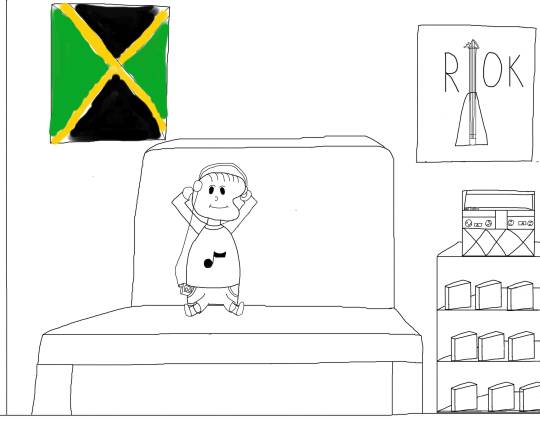
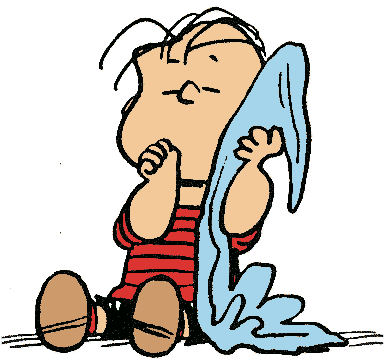
Hello everyone :). I drew here, a new character in the style of Peanuts comics named Silent. By nature, he is quiet and calm, loves music of various genres (Reggae, Rock, , bard songs and other music). He often wears headphones, which helps him hide from the negativity from his sister (Lucy the megaphone is his sister and looks like Lucy Van Pelt from the original Schultz comics in grumpy character). Speaking of similarities to the original...Silent is similar to Linus (or Linus..What's the right thing to do?) the fact that both are prone to isolation sometimes. In other words, if Linus was hiding under a blanket, then Silent does not part with headphones. Before, he (my character) flashed in one of my comics, which I will also attach to this post.

#digital illustration#digital drawing#the peanuts#charles schulz#peanuts#snoopy#drawing#comics#sketch
2 notes
·
View notes
Text
tagged by @hermioneindisguise 💕
Last song listened to: it's ok i'm ok tate mcrae
Favourite colour: green or blue but it depends on how I'm feeling. also orange but either honey orange or rust orange
Currently reading: just started Compound Fracture by Andrew Jospeh White (I have 4 other books on the go + 33 tabs of buddie fics but we won't mention any of those😅)
Currently watching: Great British Bake Off and Strictly Come Dancing (UK version of Dancing With The Stars)
Last movie watched: I barely watch movies tbh I don't even remember, I have about 100 to catch up with tho
Sweet, spicy or savoury: spicy
Relationship status: single
Current obsession: 911 and the 3 fics I'm writing right now are making me giddy (why do I have to work and not write fics all day)
Tea or coffee: I don't really drink neither tbh but maybe coffee - Pepsi max is my go to tho
The last thing I googled: wireless keyboards (I want a typewriter style one)
Tagging @redpinkwine @linus-lucy @daffi-990 @inell @dollyblogs and any one who wants to do it!
#me things#tag games#I need to watch more movies tho what was the last one I watched#I just can't sit and focus for that long
3 notes
·
View notes
Text
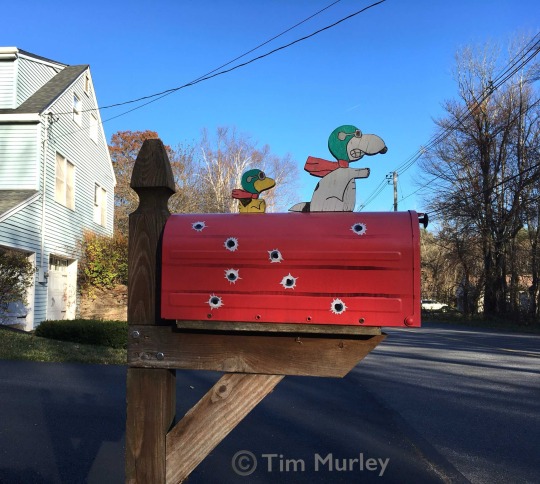
The Red Baron on a cold day. 🟥⬛️📩📮
#red baron#snoopy#snoopy and woodstock#woodstock#charlie brown#mail#snail mail#mail box#charles m schulz#peanuts#peanuts gang#great pumpkin#vince guaraldi#cell animation#animated#animation#charlie brown christmas#snoopy dog#snoopy and charlie brown#linus van pelt#the great pumpkin#lucy van pelt#cold days#snoopy art#snoopy memes#snoopy moodboard#cartoon art#cartoon style#animated tv show#the red baron
11 notes
·
View notes
Text
Stardew Characters' Spirit's Eve Costumes

This is a repost of a post from my old blog from a few years ago!
Happy Halloween / Spirit's Eve / Blessed Samhain / whatever you may celebrate today! Many people dress up in costume for this holiday - what might the residents of Stardew Valley be dressed as this year? (note: there are a few costumes of characters that likely wouldn't exist in the Stardew Valley universe, but I believe that if they did, it would be a likely fit for certain peoples' costumes.)

Abigail: Westley (from The Princess Bride)
Alex: a zombie, maybe even a zombie gridball player
Caroline: a witch
Clint: a ghost (white sheet style)
Demetrius: Gomez Addams (from The Addams Family)
Dwarf: likely doesn't celebrate the holiday (due to not following many human customs), and therefore wouldn't dress up
Elliott: Howl Pendragon (from Howl's Moving Castle)
Emily: A ghost, but full out with a - historically accurate - dress recreation from 170 years ago, white face/body paint, and shimmer powder
Evelyn: The Bride of Frankenstein
George: Frankenstein's monster
Gus: A stereotypical summer tourist (including a bum bag/fanny pack, white face paint as nose sunscreen, a floral shirt, and a far too large sunhat)
Haley: Daphne Blake (from Scooby-Doo)
Harvey: Dr. Jekyll and Mr. Hyde (one on the right, the other on the left)
Jas: Rapunzel
Jodi: A bee
Kent: Either doesn't dress up, or dresses as a pun (such as 'ceiling fan' or 'when life gives you lemons')
Krobus: Like the dwarf, he may also not celebrate this holiday, but if he does, Krobus would dress as a jack-o-lantern
Leah: Sally (from The Nightmare Before Christmas (or I suppose The Nightmare Before Winter Star?))
Leo: Pretty new to the celebration, but dresses up as a flower
Lewis: A clown (in the classic circus way, not a horror way)
Linus: A mummy
Marnie: A scarecrow
Maru: A monster truck (with actual mechanical elements)
Pam: A pirate
Penny: Ms. Frizzle (from The Magic School Bus)
Pierre: A vampire
Robin: Morticia Addams (from The Addams Family)
Sam: The Headless Horseman (likely carrying around a hobby horse and a jack-o-lantern as props)
Sandy: Lucy/Nyu (from Elfen Lied)
Sebastian: One of two options: either a last-minute skeleton costume consisting of items he had in his closet, or an Inuyasha (from Inuyasha) costume that was in development for months, and made completely from scratch
Shane: The Grim Reaper
Vincent: a bat
Willy: A cowboy
Wizard: doesn't dress up, but simply by nature of being a wizard, he is dressed as a wizard

16 notes
·
View notes
Note
Any unanswered questions for both of your f/os? 😃
Hope you have a wonderful weekend & thank you for the ask! 😊💛
Keigo/Hawks
Charlie Brown: How do you and your f/o comfort each other when youre down?
Hawks comfort me by wrapping his crimson wings & arms around me & using his words of comfort. I comfort Hawks by holding him in my arms & use sweet words. Sometimes one of us would bring the other their comfort food.
Linus: What comfort objects do you and your f/o have from each other?
What I have from Hawks are cat plushies. What Hawks have from me are jewelries & shirts.
Snoopy: What kind of pet do you and your f/o have?
We have a cat together!
Woodstock: Who is your s/i's best friend?
Best Jeanist
Peppermint Patty: Is your f/o clingy? Your s/i?
Yes, we're both clingy!
Franklin: What kind of hobbies do you and your f/o enjoy together?
We enjoy cooking/baking, doing puzzles, dancing, star gazing, card games & listening to music.
Rumi/Mirko
Charlie Brown: How do you and your f/o comfort each other when youre down?
I comfort Rumi by holding her in my arms, using my sweet words & bring her one of her comfort foods. Rumi comforts me by laying next to me while holding me in her arms & use her words of comfort. She would also bring me one of my comfort foods.
Sally: Whats you and your f/o's love languages?
Rumi & I's love language is physical touch.
Linus: What comfort objects do you and your f/o have from each other?
What I have from Rumi are the crescent moon necklace & bunny plushies. What Rumi have from me are cat plushies & yellow active top.
Lucy: Do you and your f/o pull pranks on each other?
No, we don't pull pranks on each other.
Woodstock: Who is your s/i's best friend?
Moe Kamiji (Burnin)
Marcie: What pet names do you call each other?
Rumi calls me bunny, sweetie, babe & love. I call Rumi honeybun, babe, love & bun bun.
Franklin: What kind of hobbies do you and your f/o enjoy together?
Exercise, walking, hiking, cooking/baking, yoga, pilates, dancing, weight lifting, kickboxing, hair styling & board games.
Pigpen: Which one of you and your f/o is messy and which ones tidy?
I'm the messy one & Rumi is the tidy one.
#otp: wing hero and his dove#otp: rabbit hero and her bunny#self shipping#selfshipping#self shipping community#selfshipping community#selfship community#self ship community#self shipper#selfshipper#romantic f/os#ask
11 notes
·
View notes
Text
Let's Read Peanuts (You WILL believe an unremarkable white boy can become president) – December 1958
There are lots of great strips I just don't have room to comment on. I strongly encourage everybody to read the full month at the official GoComics page. Today's month starts HERE.
December 1, 1958

It’s once again that special time of year where everybody desperately avoids making eye contact with Schroeder.
December 9, 1958

This one baffles me. Normally this kind of joke has a character doing something that cuts against one aspect of their character in order to emphasize another. For example, you might have Snoopy playing baseball with Charlie Brown saying something like “We have the only shortstop that gets drool all over the ball!”. The joke being that while Snoopy is very human in a lot of ways, he’s still a dog.
This strip isn’t rooted in any aspect of Snoopy’s character though. ~Why~ is Snoopy the only dog that can do this? He’s never been bat-like, and while he imitates other animals from time to time he’s never gained their powers in the process. You could have the “ARF” do literally anything and it would make exactly as much sense.

December 11, 1958

Replace “Westerns” with “Anime“ and “Rustlers Roundup” wi-
Actually, you know what? Screw it. We’re doing two edits in the same post. I mean, why not right? It's not like you can stop me. I am not unlike a god* in this respect.
*Specifically, one of those Shinto gods with an extremely niche and hyper-specific domain.

December 12, 1958

And we have our first appearance of Snoopy sleeping on the doghouse!
Why did this end up becoming a central pillar of the strip? No idea! Schulz probably just liked drawing it or something.
December 15, 1958

This joke has been brewing for over two weeks now. It had better be worth the buildup.
December 16, 1958

It was not worth the buildup.
December 21, 1958
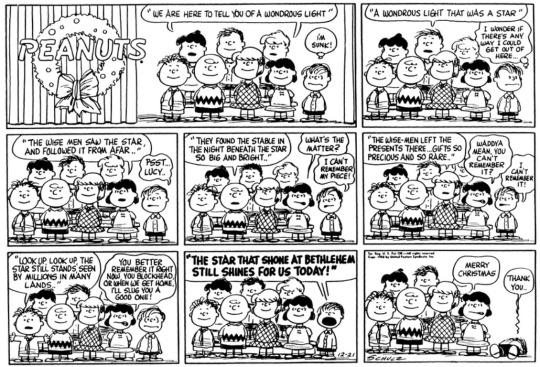
This feels very spiritually in-sync with the Christmas special. You can kind of see how the idea of overtly acknowledging the religious aspects of the holiday will evolve over the next few years. It's also very cute.
December 23, 1958

Oh, great and powerful Claus, conqueror of the skies and master of divine beasts,
Long have we anticipated your return to the realm of man, so that we may once again revel in your perfect judgement upon our wicked souls. Every day we think only of your supreme will. Every hour we enact your glorious purpose.
Should you deem it a worthy endeavor, I beg of you to shine favor upon his wretched worm. I need not gold nor fame nor even a Nintendo Switch with the limited edition Tears of the Kingdom pro controller. I seek only that my name be immortalized in the sacred pages of the Book of the Nice, so that I would know my daily toil in your name was not in vain. Grace this humble home with your crimson visage, partake of our milk of the cow and sweetened bread (purchased by mine own hands during a long and arduous pilgrimage to the Safeway), and leave not the black stone of shame in your wake.
This I wish, and nothing more. May the generous be spared your righteous anger, and may the blood of the naughty flow so freely that it’s red current floods the world and rises to meet you on your journey across the night sky.
Your lowly servant,
-Linus
P.S.: A bike and some Roblox gift cards would also be nice. Thx in advance.
Thoughts:
OK! Time for the year end roundup! Let’s start with looking at how the style has evolved so far. This time we’ll take a look at…
Lucy!
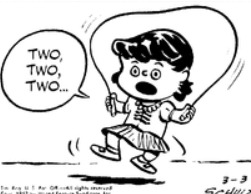
(March) 1952
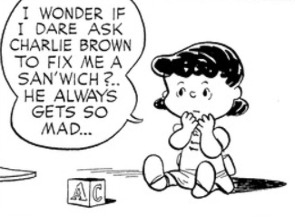
(December) 1952
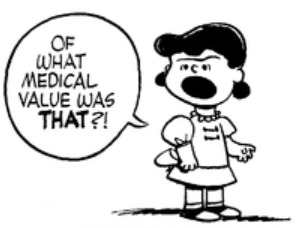
1953
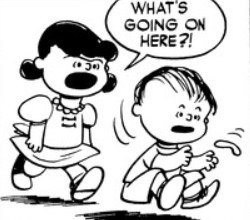
1954
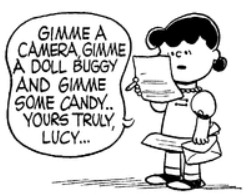
1955
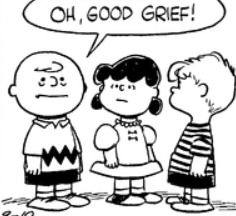
1956
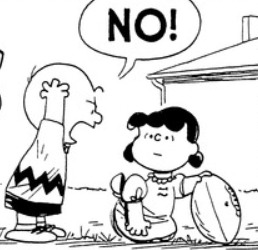
1957
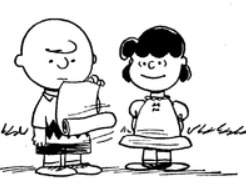
1958
Lucy is kind of interesting in that she changed quite a lot early on, but then doesn't visibly change all that much after 1955 or so. You can tell she's a bit older now and her overall look has shifted with the rest of the strip but on her own terms she's almost exactly the same as she's always been. It's not a mystery why, either. It's just a really solid design that doesn't need to be messed with.
Personality-wise though she's actually changed quite a bit due in no small part to her brother continuing to grow up and become his own person. It's changed a lot about how she interacts with him (talking with him, teaching him stuff, trying to look out for his interests in her own unique way), and this change has altered her relationships with everybody else. I mean, she's still a pain in the ass, but she's now terrorizing people in a more sophisticated and mature way. It's great, and I'm starting to actually like her as a character and not just as a funny antagonistic force (who I thought was kind of awful as a person).
On a larger scale the art hasn't really changed all that much this year but I do think it's been "refined" a bit. Around 1955 the art took that weird shift into a more blocky look (I lovingly call this the "fat kid" Peanuts era) and it always bothered me because I felt like some of the expressiveness and really solid draftsmanship of the early strips got lost in the transition. This year though I think the strip is finally making it work. The line work is a bit more loose and expressive and Schulz getting better at letting the character's unique personalities show through. We also got an uptick in the number of those detailed backgrounds we got in the early days, which was nice to see. Though I suspect that we'll still see fewer of them going forward.
You can also start to see the look of the "classic" peanuts era of the 60s-70s just beginning to emerge, which is pretty neat!
The biggest beneficiary of this year by far though is Snoopy, who's stretchy half-human cartoon look is finally starting to work for him. It's still ~a bit~ awkward and off-putting, but it's at a place now where it works more than it doesn't. I think it's the snout maybe? It was very long and wobbly before but recently it's been drawn in a much more short and round way that's a lot more cute. I don't know, you tell me (Engage the algorithm! Comment! Like! Subscribe!).
1957:

1958:
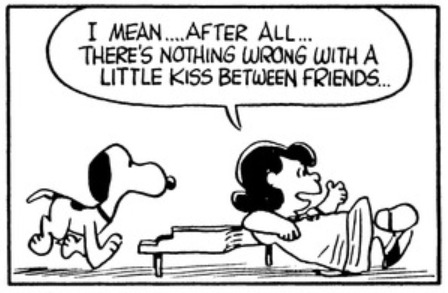
Overall I'd say that this year was another solid step up from the prior one (which was a step up from the one before that). Still not as good as 1953-1954 but we're getting close.
#peanuts#comic strips#charles schulz#comics#peanuts comics#lets read#charlie brown#snoopy#lucy#schroeder#Linus#Patty#Shermy#Pigpen#Violet#beethoven#Christmas
17 notes
·
View notes
Text
[Image description: Images 1 and 2: Two photos of a cat trying to climb onto a train. A train conductor picks it up and takes it out.
Image 3: A Peanuts strips showing most of the human cast standing in line behind Snoopy. Lucy says, "Go ahed! Let him in!" Linus: "Show him a little kindness!" Peppermint Patty: "Let him in!" Marcie: "Show a little love!" Franklin: "Let him hin!" Violet: "Show a little compassion!" Snoopy thinks, "My friends…"
Image 4: The words "I would let Him ride the Amtrak" in the style of the Teenage Mutant Ninja Turtles logo. End description.]
[Plain text: (Music note emoji) Kitty on a mass rail! Transit power! (Music note emoji) End plain text]
@a-captions-blog


No ticket no ride 😿
#op please add the description to the original post#in plain text and not under a read more#described#cats#animals#pets#trains#teenage mutant ninja turtles
27K notes
·
View notes
Text
Diablos Rojos x Peanuts Comic Edition Baseball Jersey

Link Product: https://inspirdg.com/product/diablos-rojos-x-peanuts-comic-edition-baseball-jersey/
Diablos Rojos x Peanuts Comic Edition Baseball Jersey: A Grand Slam of Playful Legacy and LMB Pride
When comic nostalgia collides with baseball brilliance, the result is nothing short of iconic. The Diablos Rojos x Peanuts Comic Edition Baseball Jersey is a dazzling tribute to two titans of pop culture: the beloved Mexican League powerhouse Diablos Rojos del México and the universally adored Peanuts comic strip by Charles M. Schulz. This masterpiece of wearable design transforms timeless storytelling into a lively, energetic garment that’s bursting with personality, heritage, and youthful charm.
Created to celebrate the 100th Anniversary of the Liga Mexicana de Béisbol (LMB), this jersey delivers not just a stunning aesthetic, but a full-hearted celebration of generations that have laughed, cheered, and loved both baseball and the Peanuts gang.
Front Design: Comic Strip Gold and Fiery Tradition
The front of the jersey is a visual feast—a black-and-white mosaic of original Peanuts comic strip panels, bringing scenes of Charlie Brown, Lucy, Snoopy, and friends to life across every inch of the body. It’s not just a background—it’s the heart of the jersey, a reminder that great storytelling and great sports both thrive on emotion, connection, and community.
Layered proudly over this comic tapestry is the classic red Diablos script, swooping across the chest like a signature on a well-worn glove. Diablos fans will recognize its sharp edges and vintage energy immediately. Below the logo, Snoopy and Charlie Brown are featured in full color, creating a bold contrast against the monochrome background—instantly drawing the eye and making the Peanuts universe feel alive and animated.
Every inch of this design is deliberate, bold, and deeply charming. It’s not just a jersey—it’s a mural you wear.
Back Design: Full-Circle Celebration of Baseball and Friendship
The back of the jersey expands the celebration. Taking center stage is a large, circular red-and-yellow Diablos crest, reading “Diablos Rojos del México”—surrounded by bright, energetic color that pops against the comic background. It’s a declaration of club pride that feels official, ceremonial, and deeply festive.
Beneath this emblem, the Peanuts crew reappears—this time fully colored and lined up in their baseball uniforms, bats ready and smiles wide. From Linus to Sally to Pigpen, the entire crew is present, representing teamwork, mischief, and that innocent, can-do spirit that baseball so effortlessly captures.
Whether you're a die-hard Diablos fan or a lifelong Peanuts reader, this jersey taps into the core of what it means to love the game and the characters we grew up with.
Sleeve Details: A Fusion of Icons
The sleeves take a bold red turn, creating visual balance while echoing Charlie Brown’s signature zigzag motif through white chevron patterns. It’s a subtle but powerful nod to one of the most recognizable characters in comics. The left and right sleeves also showcase the LMB 100 patch and Diablos “M” logo, grounding the design in historical context and league prestige.
These details prove the jersey was not just created for commercial novelty—it was crafted with reverence and flair, meant to celebrate both a century of baseball and the enduring legacy of one of the world’s most cherished comic franchises.
Fabric & Fit: Style Meets Comfort
Visually striking, yes—but the jersey also scores high on comfort and function. Constructed from a lightweight performance polyester blend, it’s breathable, moisture-wicking, and ideal for game day wear or casual daily style. The athletic cut is flattering and flexible, suitable for fans of all ages.
Whether you’re in the stands, on the field, or lounging at home with peanuts (pun intended), this jersey offers style without sacrifice. It's also a brilliant conversation starter—turning heads and sparking smiles wherever you go.
A Celebration of Culture, Character, and Community
This is more than just apparel—it’s a shared celebration. The Diablos Rojos x Peanuts Comic Edition Baseball Jersey is a joyful collision of North American sports culture, timeless comic artistry, and Mexican baseball pride. It brings together generations of fans, from kids just discovering Snoopy’s antics to grandparents who grew up with Charlie Brown and followed Diablos’ greatest seasons.
In a world that often separates entertainment and sport, this jersey reminds us they can thrive together—and be all the better for it.
Conclusion: The Perfect Crossover Hit
The Diablos Rojos x Peanuts Comic Edition Baseball Jersey is a grand slam in every sense. It pays homage to the heroes of the diamond and the heroes of the page, blending nostalgia, athleticism, and visual storytelling in a way few garments ever do.
If you believe in the power of laughter, the magic of baseball, and the joy of shared traditions, then this jersey belongs in your collection. Because when Charlie Brown meets the Diablos—everyone wins.
0 notes